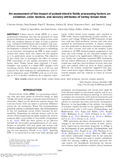An assessment of the impact of pulsed electric fields processing factors on oxidation, color, texture, and sensory attributes of turkey breast meat

View/
Date
2015Author
Arroyo, Cristina
Eslami, Sara
Brunton, Nigel P
Arimi, Joshua M
Noci, Francesco
Lyng, James G
Metadata
Show full item recordAbstract
Pulsed electric fields (PEF) is a novel nonthermal technology that has the potential to cause physical disruption to muscle tissue which in turn could alter the sensorial aspects of meat in both a positive (e.g., enhanced tenderization) and a negative way (e.g., off-flavor development). If there is a risk of off-flavor development it should be identified prior to embarking on an extensive investigation on PEF in meat tenderization and turkey meat was chosen for this purpose as it is particularly prone to oxidation. The objective of this study was to investigate the effect of various PEF treatments on the quality attributes of turkey breast meat. Turkey breast meat obtained 1 d postslaughter was treated in a batch PEF chamber with increasing electric field strength up to 3 kV/cm and analyzed for lipid oxidation by thiobarbituric acid reactive substances assay (TBARS) with up to 5 d storage at 4°C in aerobic conditions. In a separate experiment, turkey breast meat samples were exposed to PEF under various combinations of pulse number, frequency, and voltage. Following PEF treatments weight loss, cook loss, lipid oxidation, texture, and color were assessed by instrumental methods. A sensory analysis was also performed to determine consumer acceptability for color, texture, and odor of the samples. Lipid oxidation in all PEF-treated samples progressed at the same rate with storage as the untreated samples and was not found to be significantly different to the control. Under the conditions examined PEF treatments did not induce differences in instrumentally measured weight loss, cook loss, lipid oxidation, texture, and color (raw and cooked) either on fresh or frozen samples. However, the sensory evaluation suggested that panelists could detect slight differences between the PEF-treated samples and the controls in terms of texture and odor.
